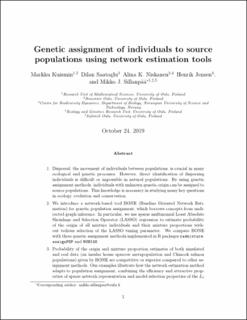| dc.contributor.author | Kuismin, Markku | |
| dc.contributor.author | Saatoglu, Dilan | |
| dc.contributor.author | Niskanen, Alina Katariina | |
| dc.contributor.author | Jensen, Henrik | |
| dc.contributor.author | Sillanpää, Mikko J. | |
| dc.date.accessioned | 2020-04-02T13:02:27Z | |
| dc.date.available | 2020-04-02T13:02:27Z | |
| dc.date.created | 2019-11-13T09:09:31Z | |
| dc.date.issued | 2019 | |
| dc.identifier.citation | Methods in Ecology and Evolution. 2019, 11 333-344. | en_US |
| dc.identifier.issn | 2041-210X | |
| dc.identifier.uri | https://hdl.handle.net/11250/2650120 | |
| dc.description.abstract | Dispersal, the movement of individuals between populations, is crucial in many ecological and genetic processes. However, direct identification of dispersing individuals is difficult or impossible in natural populations. By using genetic assignment methods, individuals with unknown genetic origin can be assigned to source populations. This knowledge is necessary in studying many key questions in ecology, evolution and conservation.
We introduce a network‐based tool BONE (Baseline Oriented Network Estimation) for genetic population assignment, which borrows concepts from undirected graph inference. In particular, we use sparse multinomial Least Absolute Shrinkage and Selection Operator (LASSO) regression to estimate probability of the origin of all mixture individuals and their mixture proportions without tedious selection of the LASSO tuning parameter. We compare BONE with three genetic assignment methods implemented in R packages radmixture, assignPOP and RUBIAS.
Probability of the origin and mixture proportion estimates of both simulated and real data (an insular house sparrow metapopulation and Chinook salmon populations) given by BONE are competitive or superior compared to other assignment methods. Our examples illustrate how the network estimation method adapts to population assignment, combining the efficiency and attractive properties of sparse network representation and model selection properties of the L1 regularization. As far as we know, this is the first approach showing how one can use network tools for genetic identification of individuals' source populations.
BONE is aimed at any researcher performing genetic assignment and trying to infer the genetic population structure. Compared to other methods, our approach also identifies outlying mixture individuals that could originate outside of the baseline populations. BONE is a freely available R package under the GPL licence and can be downloaded at GitHub. In addition to the R package, a tutorial for BONE is available at https://github.com/markkukuismin/BONE/. | en_US |
| dc.language.iso | eng | en_US |
| dc.publisher | Wiley | en_US |
| dc.title | Genetic assignment of individuals to source populations using network estimation tools | en_US |
| dc.type | Peer reviewed | en_US |
| dc.type | Journal article | en_US |
| dc.description.version | acceptedVersion | en_US |
| dc.source.pagenumber | 333-344 | en_US |
| dc.source.volume | 11 | en_US |
| dc.source.journal | Methods in Ecology and Evolution | en_US |
| dc.identifier.doi | 10.1111/2041-210X.13323 | |
| dc.identifier.cristin | 1746850 | |
| dc.relation.project | Norges forskningsråd: 274930 | en_US |
| dc.relation.project | Norges forskningsråd: 223257 | en_US |
| dc.relation.project | Norges forskningsråd: 221956 | en_US |
| dc.description.localcode | Locked until 29.10.2020 due to copyright restrictions. This is an [Accepted Manuscript] of an article published by Taylor & Francis, available at https://doi.org/10.1111/2041-210X.13323 | en_US |
| cristin.ispublished | true | |
| cristin.fulltext | preprint | |
| cristin.fulltext | postprint | |
| cristin.qualitycode | 2 | |
